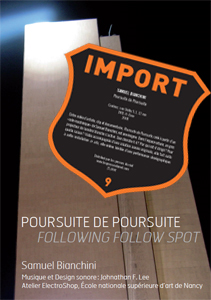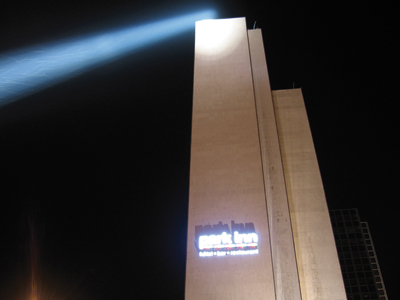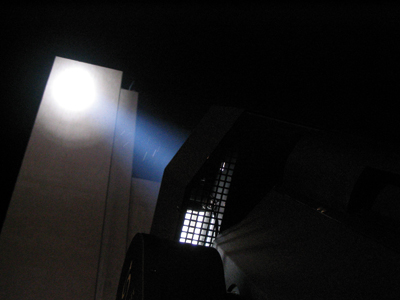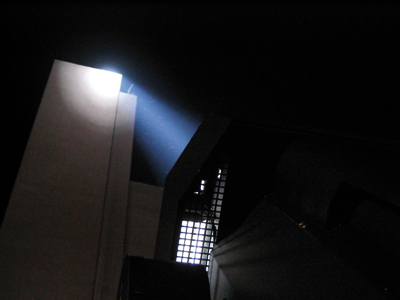Train station city square and the Thiers tower, Nancy, on the evening of May 6th into the morning
of May 7th, 2006: a large white light projector is activated following the movements of a possible
operator seeking to reveal and follow a presence, perhaps that of a performer, but neither the operator nor the performer are present.
Reporting on this operation, this video also reactivates the original performance of Paul-André Fortier through a musical creation of Johnathan F. Lee developed from the sound captured during the dance solo 30 x 30, in the same urban space.
Johnathan F. Lee is an American digital sound artist and composer living in Tokyo, where he is an Assistant Professor in the Department of Media Arts at Tamagawa University. His compositions encompass a variety of styles and formats, both instrumental and electroacoustic, with an emphasis on creating distinctive layers of sound, often through the use of signal processing techniques.
In recent years, his artistic interests have focused on collaborations with artists from other disciplines—particularly choreographers and visual artists—in works that have been presented in Asia, North America, South America, and Europe. Additionally, he has worked on numerous research and software development projects focusing on sound and arts technology at various institutions worldwide including Columbia University and IRCAM.
He received a doctorate in music composition (DMA) from Columbia University. Prior to moving to Japan in 2006, he taught at Columbia and Adelphi Universities in New York.
Samuel Bianchini (born 1971 in Nancy, France, lives and works in Paris) is today artist and Associate Professor at the
École Nationale Supérieure des Arts Décoratifs (Ensad, Paris), where he is the head of the research program
Reflective Interaction, on Interactive and Performative Installations.
He shows regularly in France and abroad. Exhibitions have included institutions such as Art Basel 2013, Institut français de Tokyo, Stuk Art Center (Leuven, Belgium), Centre Georges Pompidou in Paris, Deutsches Hygiene-Museum in Dresden, National Museum of Contemporary Art in Athens,
Jeu de Paume in Paris, Laboratoria in Moscow, Jozsa Gallery in Brussels, Thessaloniki Biennale of Contemporary Art, Centre pour l'image contemporaine of Geneva, Rennes Biennale, Nuit Blanche in Paris, space_imA and Duck-Won Gallery in Seoul,
Villa Arson in Nice, La Ménagerie de verre in Paris, Ateneo de Yucatán Museum of Contemporary Art in Mexico City, Cité des Sciences et de l'Industrie in Paris, Zentrum für Kunst und Medientechnologie (ZKM) in Karlsruhe, Musée d'Art Moderne de la Ville de Paris.
His work investigates the impact of technology on modes of representation, on our new forms of aesthetic experiences and our socio-political organizations. To bring his projects to fruition, he collaborates with scientists and technology research centers such as the Centre de Recherche en Informatique du Cnam (Conservatoire National des Arts et Métiers in Paris), Orange Labs, the Limsi-CNRS (Laboratoire pour la mécanique et les sciences de l'ingénieur, Orsay), and IEMN-CNRS (Institut d'Électronique de Microélectronique et de Nanotechnologie, Lille-Valenciennes), CEA (French Atomic Energy Commission, Saclay).
In tight correlation with his artistic practice, Samuel Bianchini has undertaken theoretical work that has been published by the Centre Pompidou, Jean-Michel Place, MIT Press,
Analogues, Burozoïque, Hermes, etc.






